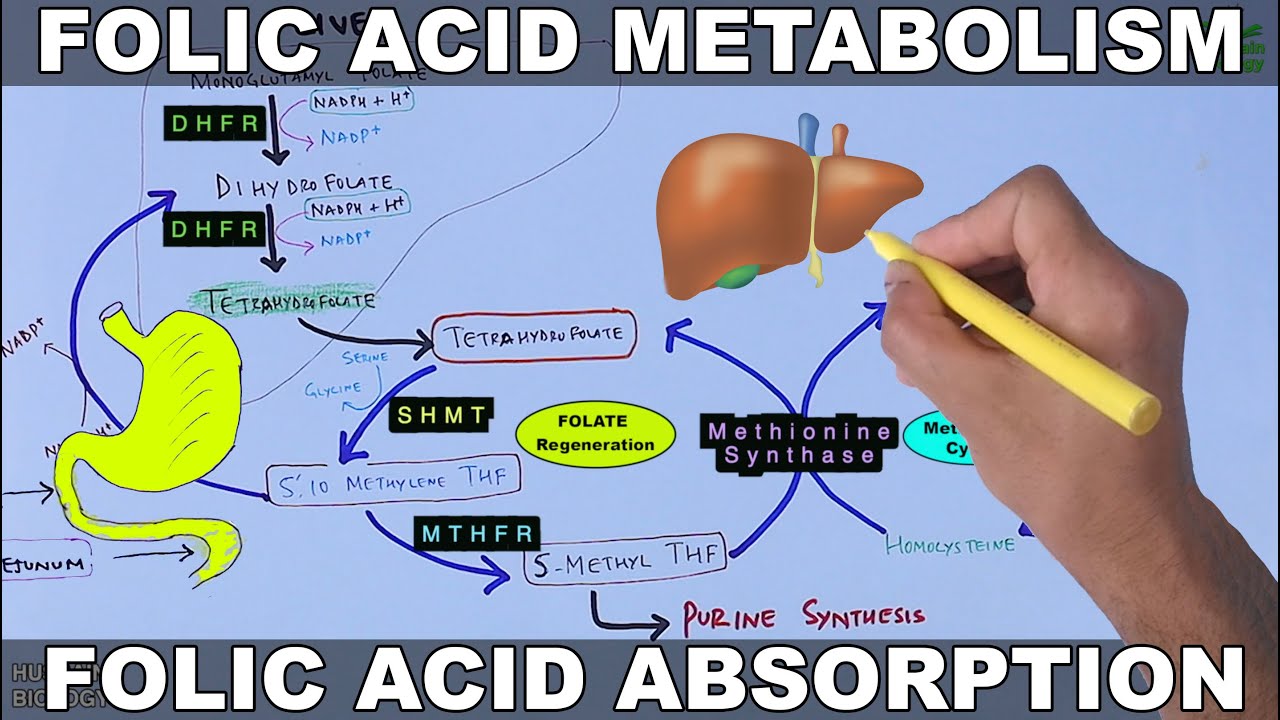Folate & B12 Deficiency, Megaloblastic Anemia Hypersegmented Macrocytic Methylmalonic
Summary
TLDRThis video covers folate and vitamin B12 deficiencies, focusing on their role in DNA synthesis and cellular division. It explains how deficiencies can lead to megaloblastic anemia, neural tube defects, and the importance of these vitamins in pregnancy, infancy, and conditions like hemolytic anemia. The video also highlights the interaction between folate and B12, where B12 deficiency can mimic folate deficiency. Further, it emphasizes the dangers of treating B12 deficiency with folate alone, which could lead to irreversible neurological damage. The content serves as an essential guide for medical students preparing for Step 1 exams.
Takeaways
- 😀 Folate (Vitamin B9) is crucial for methylation, one-carbon chemistry, and DNA nucleic acid creation, especially in tissues undergoing rapid cellular division like hematopoietic cells.
- 😀 Folate deficiency is more common in conditions with increased demand, such as pregnancy, infancy, and diseases like hemolytic anemia.
- 😀 The primary cause of folate deficiency is an increased need for folate, not just a lack of intake, as seen in pregnancy or conditions requiring rapid cell division.
- 😀 Neural tube defects, such as spina bifida, are a common manifestation of folate deficiency, especially in pregnant women.
- 😀 Folate deficiency presents as megaloblastic anemia, characterized by large red blood cells due to impaired DNA synthesis, and increased homocysteine levels.
- 😀 Megaloblastic anemia is a type of macrocytic anemia where red blood cells are enlarged because of stalled cell division during hematopoiesis.
- 😀 Hypersegmented neutrophils in a blood smear are a hallmark of folate deficiency and megaloblastic anemia.
- 😀 Folate’s biochemical pathway involves its conversion to tetrahydrofolate (THF), which is necessary for DNA creation by producing nucleic acids.
- 😀 Both folate and B12 are required to convert homocysteine into methionine, and deficiencies in either lead to elevated homocysteine levels.
- 😀 B12 deficiency can mimic folate deficiency because B12 is required to regenerate active folate; however, B12 deficiency has additional neurological symptoms.
Q & A
What are the primary functions of folate in the body?
-Folate, also known as vitamin B9, plays a crucial role in methylation, one-carbon chemistry, and the creation of DNA nucleic acids. These functions are particularly important in tissues with frequent cellular division, such as hematopoietic cells and during periods of rapid cellular division like pregnancy and infancy.
Why is folate deficiency commonly seen during pregnancy?
-During pregnancy, both the mother and fetus undergo rapid cellular division, requiring more DNA synthesis. This increased demand for folate can lead to a deficiency if the body cannot meet the higher requirements, potentially resulting in neural tube defects like spina bifida.
What are some common causes of folate deficiency?
-Folate deficiency can result from increased demand (e.g., pregnancy, infancy, or hemolytic anemia), certain medications (e.g., trimethoprim, methotrexate), or decreased intake, though the latter is rare due to fortification in foods like grains and cereals.
What is megaloblastic anemia, and how is it related to folate deficiency?
-Megaloblastic anemia is a type of anemia characterized by large, immature red blood cells (macrocytes). It occurs in folate deficiency due to a lack of DNA synthesis, which causes the red blood cells to grow larger without dividing properly.
How does folate deficiency affect white blood cells?
-Folate deficiency can lead to the presence of hypersegmented neutrophils in blood smears, which are neutrophils with nuclei containing five or more segments. This is a key diagnostic feature of megaloblastic anemia.
How does folate deficiency affect homocysteine levels?
-In folate deficiency, there is an inability to recycle folate, leading to a lack of methyl groups for converting homocysteine into methionine. As a result, homocysteine levels build up, which can contribute to cardiovascular disease risk.
How is vitamin B12 related to folate metabolism?
-Vitamin B12 plays a critical role in recycling folate by removing methyl groups from methyl tetrahydrofolate, allowing it to be used for DNA synthesis. A deficiency in B12 can thus cause a functional folate deficiency, contributing to megaloblastic anemia.
What are the additional symptoms and laboratory findings associated with B12 deficiency compared to folate deficiency?
-In addition to the megaloblastic anemia seen in both B12 and folate deficiencies, B12 deficiency can lead to neurological symptoms such as peripheral neuropathy, spasticity, and sensory loss (e.g., vibration and proprioception). Laboratory tests show elevated methylmalonic acid levels in B12 deficiency, which is not seen in folate deficiency.
Why is it important to differentiate between B12 and folate deficiencies when treating a patient?
-Although folate supplementation can correct the anemia caused by B12 deficiency, it does not address the neurological damage associated with B12 deficiency. Administering folate without B12 can worsen neurological symptoms in patients with B12 deficiency.
What are the key steps in the absorption of vitamin B12, and how can these be disrupted?
-Vitamin B12 absorption begins when it is separated from food proteins by stomach acid. It then binds to intrinsic factor released by parietal cells, which transports it to the ileum for absorption. Disruptions to this process, such as gastric acid reduction, intrinsic factor deficiency (e.g., pernicious anemia), or ileal damage (e.g., Crohn's disease), can lead to B12 deficiency.
Outlines

This section is available to paid users only. Please upgrade to access this part.
Upgrade NowMindmap

This section is available to paid users only. Please upgrade to access this part.
Upgrade NowKeywords

This section is available to paid users only. Please upgrade to access this part.
Upgrade NowHighlights

This section is available to paid users only. Please upgrade to access this part.
Upgrade NowTranscripts

This section is available to paid users only. Please upgrade to access this part.
Upgrade NowBrowse More Related Video
5.0 / 5 (0 votes)





